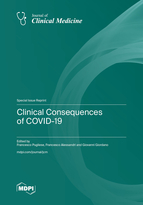Clinical Consequences of COVID-19
A special issue of Journal of Clinical Medicine (ISSN 2077-0383). This special issue belongs to the section "Epidemiology & Public Health".
Deadline for manuscript submissions: closed (15 July 2023) | Viewed by 28364
Special Issue Editors
Interests: intensive care medicine; lung-kidney-liver transplants; ECMO; COVID-19
Special Issues, Collections and Topics in MDPI journals
Interests: intensive care medicine; ECCO2R; delirium; ultrasound; COVID-19; polytrauma
Special Issues, Collections and Topics in MDPI journals
Interests: critical care; intensive care medicine; anesthesiology; ecmo; extracorporeal
Special Issues, Collections and Topics in MDPI journals
Special Issue Information
Dear Colleagues,
In 2019, a novel severe acute respiratory syndrome coronavirus-2 (SARS-CoV-2) caused a global pandemic, representing a major public health crisis. SARS-CoV-2 can infect all age groups, regardless of gender, ethnicity, and general health status. Direct contact, aerosol, and droplet transmission are the three main routes of SARS-CoV-2 transmission. Although the pulmonary system is its primary entry site, several non-respiratory clinical symptoms alongside cumulating anatomical evidence have demonstrated the virus’s potential to invade multiple organs throughout the body, including the nervous system. There is wide consensus that the COVID-19 pandemic not only affects physical health, but also mental health and wellbeing. Because COVID-19 is a new disease, much about the clinical course and the possible long-term health consequences remains uncertain.
Dr. Francesco Pugliese
Dr. Francesco Alessandri
Dr. Giovanni Giordano
Guest Editors
Manuscript Submission Information
Manuscripts should be submitted online at www.mdpi.com by registering and logging in to this website. Once you are registered, click here to go to the submission form. Manuscripts can be submitted until the deadline. All submissions that pass pre-check are peer-reviewed. Accepted papers will be published continuously in the journal (as soon as accepted) and will be listed together on the special issue website. Research articles, review articles as well as short communications are invited. For planned papers, a title and short abstract (about 100 words) can be sent to the Editorial Office for announcement on this website.
Submitted manuscripts should not have been published previously, nor be under consideration for publication elsewhere (except conference proceedings papers). All manuscripts are thoroughly refereed through a single-blind peer-review process. A guide for authors and other relevant information for submission of manuscripts is available on the Instructions for Authors page. Journal of Clinical Medicine is an international peer-reviewed open access semimonthly journal published by MDPI.
Please visit the Instructions for Authors page before submitting a manuscript. The Article Processing Charge (APC) for publication in this open access journal is 2600 CHF (Swiss Francs). Submitted papers should be well formatted and use good English. Authors may use MDPI's English editing service prior to publication or during author revisions.
Keywords
- COVID-19
- long COVID-19
- SARS-CoV-2
- mental health
- COVID-19 health consequences








